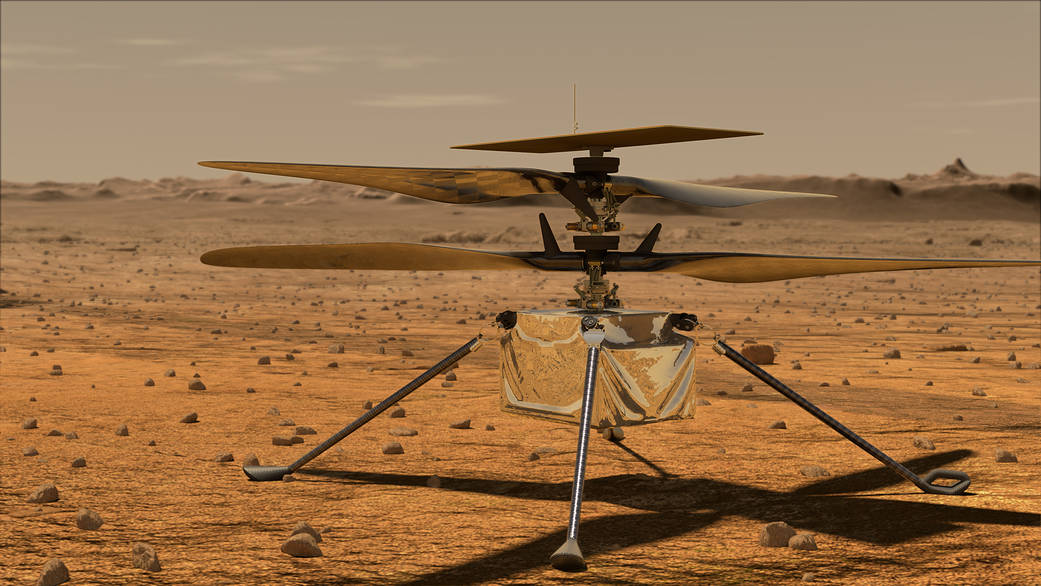In a first, a hardy Earth-born helicopter takes flight on another planet.
Credits: NASA/JPL-Caltech
Taking flight a literal world away from the wind-swept dunes of North Carolina’s Outer Banks where Wright brothers Orville and Wilbur made aeronautical history, the Mars Ingenuity Helicopter—Ginny, for short—made its own historical mark on April 19, 2021. From a spot in Jezero Crater now named Wright Brothers Field, Ginny rose to 10 feet (3 meters) above Martian soil, briefly hovered, completed a turn, and then landed.
As confirmation of success came, jubilation was the order of the day at Ginny’s birthplace, NASA’s Jet Propulsion Laboratory (JPL) in Pasadena, CA. Thanks to a series of rigorous JPL tests attesting to its hardiness, the diminutive, 4-pound (1.8 kg) craft that measures 4 feet (1.2 meters) blade tip to blade tip, rose to the occasion.
“The Mars helicopter is absolutely unique. We haven’t done anything like it before,” said Andy Rose, technical group supervisor for the JPL Environmental Thermal Laboratory. “Frankly, I didn’t know if it would work. But it flew during our tests, and now we know it can fly on Mars.”
During testing in 2019, Ingenuity underwent a multi-week evaluation under Mars-like conditions replicated inside JPL’s 25-foot-wide, 85-foot-tall (8-meter-by-26-meter) vacuum chamber. The wispy, mostly-carbon-dioxide Martian atmosphere—less than 1 percent as thick as Earth’s—was simulated as Ginny was put through its paces, its gear checked and rechecked, and eventually deployed from the belly of the Perseverance rover for short, restrained flights within the chamber’s cozy confines.
“Testing is absolutely crucial for success of these missions,” Rose said. “Running tests reveal the underlying problems that could arise. For Mars 2020, there weren’t many issues. The more we’ve done this, the better we’ve gotten.”
Properly speaking, Ginny is a technology demonstrator, a proof-of-concept vehicle that isn’t the primary focus of the Mars 2020 mission whose rover, Perseverance, is the star of the show. With a range of 980 feet (300 meters) and a flight ceiling of 15 feet (5 meters), the helicopter won’t be flying long distances at great heights, but should nevertheless provide new aerial perspectives on red-planet geology and views into areas that are too steep or slippery for a rover to operate without mishap.
The primary aim of Mars 2020 is to search for signs of ancient life and collect samples of rock and sediment in tubes, caching them the planet’s surface for eventual return to Earth. A potential future robotic mission could gather the samples, and then ferry them back for analysis in terrestrial laboratories by equipment too large or bulky to be cost-effectively launched to Mars.
Testing of the sort done at JPL for Mars 2020 that evaluated the performance of both the Perseverance rover and Ginny the helicopter will continue to play a central role as future generations of rockets and payloads—and human explorers—rumble to orbit and beyond. Figuring out what problems are likely to occur and then devising solutions that can be quickly applied under a variety of scenarios is what space-missions testing is all about.
“Testing happens to see what can go wrong. Once you know that, you fix it, and move on to see what else might trip you up,” said Space Environments Testing Management Office (SETMO) Director Mike Mastaler. SETMO supports and advocates for NASA-wide space-missions testing in a number of facilities and research laboratories across the agency, including the JPL chamber in which Ingenuity took its fledgling first flights.
More information here:
https://mars.nasa.gov/files/mars2020/MarsHelicopterIngenuity_FactSheet.pdf
https://mars.nasa.gov/technology/helicopter/#Quick-Facts
https://mars.nasa.gov/mars2020/



























